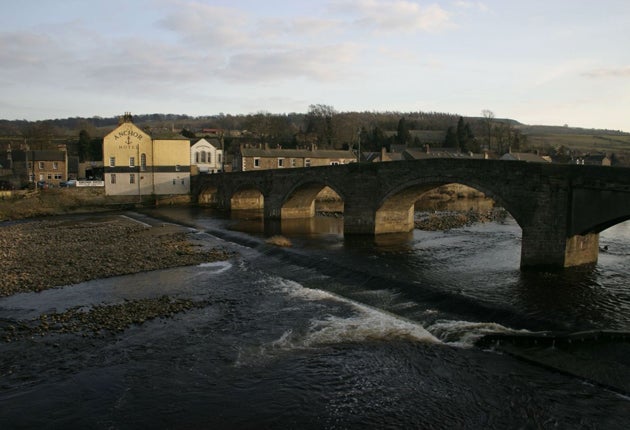A guide to A-road Britain: A686
It winds its way from Haydon Bridge, across the 'roof of England', to the gateway to the Lakes. Simon Turnbull enjoys some beans on toast and a fantastic view at the highest café in England

There were plenty of signs in the window of Claire's Newsagents on Church Street – "Grazing land wanted"; "Bats talk at Haydon Bridge Methodist Church" – but no indication of any life.
It was 2pm on a Sunday and, clearly, Claire had shut up for the day. At the corner, Tony Petts was cleaning the windows of his art gallery. "John Clarke's Newsagents is where Claire's Newsagents is now," he said.
Philip Larkin used to buy his Sunday paper at John Clarke's when he stayed with Monica Jones at 1a Ratcliffe Road in Haydon Bridge, a Northumberland village just south of the wall Hadrian's legions built as a final frontier. It was life, Jim, but probably not as the legionaries knew it in sunnier reaches of the Roman Empire.
"This is Ratcliffe Road here," Mr Petts added. "That's No 1 across the road." He pointed to a terrace house backing on to the fast-flowing South Tyne.
"Your little house seemed distinguished and exciting and beautiful," Larkin wrote to his Monica after he first visited her there in April 1962. "You have a great English river drifting under your window." And a great road heading south, the poet might have added.
There are only 35 miles of the A686 but the winding route stretches through some breathtaking scenery, up over "the roof of England" – as the 1,903ft (580m) Hartside Summit, the highest point in the Northern Pennines, has been called – before descending to Penrith, the northern gateway to the Lake District.
There is a hint of the majesty to come on the 17-mile climb up to Alston: hairpin bends, pine forests, open moorland. At 1,000ft, Alston is the highest market town in England. Alfred Wainwright visited on his epic Pennine journey in 1938. "The town clings to a hillside so steep that the houses seem to be piled one above another," he wrote, "and an odd assortment they are." There's a Quaker Meeting House, several antique shops and a café called Pizza This, Pizza That.
On the steep climb up Hartside Moor, the sky was as black as thunder. There was one small chink in the cumulonimbi, diverting a shaft of light towards a grey stone building at the summit. The Hartside Top Café appeared like a heavenly vision.
At 1,903ft, it is the highest café in England. Looking down on the other side of the zig-zagging Hartside Pass is the lush garden of the Eden Valley and beyond, like a giant's backbone, the outline of the Northern Lakeland fells: Helvellyn, Blencathra, Great Gable. "I'll never forget the first time I came up here," Ian Douglas pondered, clutching a steaming mug of coffee, one of an army of bikers – motor-bikers – drinking in the scene in their squeaky leathers. "Oh, terrific, it was. What a spectacular view."
Mr Douglas and his friend, Trevor Edwards, had ridden on their Kawasakis from Dalton-in-Furness, near Barrow. There were 47 motor bikes jammed into the car park, outnumbering 21 cars, two vans and eight bicycles. "The bikers do a midnight run up here once a year," Mr Douglas said. "They open up the café and raise money for the air ambulance fund." Inside, pinned on the noticeboard next to the till was a letter from the Great North Air Ambulance thanking the café and the bikers for raising £850.02 last year. There was also a clipping from a magazine feature about the best cafés in Britain. "If they have greasy spoons in heaven, they must be like the Hartside Café," Stuart Maconie gushed. It was difficult to disagree. What with the divine vista, and beans on toast and Vimto for £3.50, it could hardly get much better.
"It was originally built in 1910 as a transport caff for the lorries," Kathryn Renwick, the affable manageress, said, pulling up a chair. "It was just a wooden shack then. It's quite a famous road because it was one of the first in England that was tarmacked. This is actually known as Fiend's Fell. The Romans called it that because it was so bitter and cold.
"We have had Prince Charles in here on a private visit. And the two Hairy Bikers often come. We've had Robbie Coltrane too."
It was all downhill from Kath's cracker of a caff, a twisting descent to the Eden Valley and on to the road's end at Penrith. The A686 gave way to route 66 – Scotch Corner to the east, Keswick to the west. There was only one choice: a full circle of the roundabout and back up heaven's road to Haydon Bridge.
Join our commenting forum
Join thought-provoking conversations, follow other Independent readers and see their replies
Comments